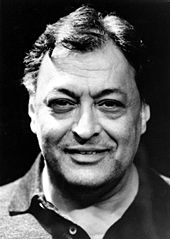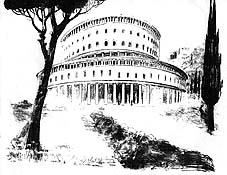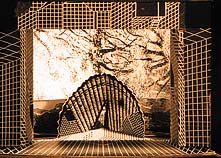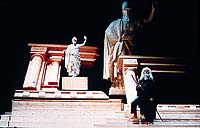This year the curtain went up in April on the 62nd edition of the Maggio Musicale Fiorentino at the Teatro del Maggio with Cajkovsky's Dama di Picche, conducted by Semyon Bychkov and directed by Lev Dodin; in May instead it rises on "Il Ritorno di Elena" (Mikroutsikos), at the Teatro Verdi, conducted by Alexander Myrat (director Georg Rootering), followed, at the Teatro del Maggio, by Tristan und Isolde by Wagner with Zubin Mehta on the podium, director Klaus Michael Grüber; Il Ritorno di Ulisse in Patria by Monteverdi, with The English Concert conducted by Trevor Pinnock under the direction of Luca Ronconi (Pergola); Pelleas et Mélisande di Debussy conducted by Giuseppe Sinopoli, director Dieter Dorn (Maggio). Thus the three main theatres in the city - the Maggio, the Verdi and the Pergola - are being used for the festival this year (further details on page 52), as well as of course the Piccolo Teatro of the Maggio where, as usual, debates will be held on all the events as well as a series of concerts and ballets (Teorema, with choreography by David Bombana, Tokyo Ballet, Neoclassica, choreographed by Hans van Manen, Rudy van Danzig and David Bombana; the ballet programme concludes with the grand gala in ***Piazza della Signoria*** on July 3rd). It appears however that no performances have been planned at that beautiful theatre in miniature, Teatro Goldoni, in Via Santa Maria, restored and reopened last March to commemorate the 4th centenary of the birth of melodrama.
 |
| Zubin Mehta |
There will certainly be more orchestra conductors mounting the podium than theatres of course; apart from the unfailing presence of Zubin Mehta, highly popular in Florence, now his second home (he surely deserves to be made an honorary citizen, unless he already is), other famous visiting conductors to the festival are Semyon Bychkov, Alexander Myrat, Trevor Pinnock, Giuseppe Sinopoli, David Robertson and Wolfgang Sawallisch; there will also be concerts by Andrea Lucchesini, Vladimir Ashkenazy, Stephan Genz with Roger Vignoles, the Orchestra G. Cantelli, The New Hellenic Quartet, Michele Campanella, Kristian Zimmermann, Maurizio Pollini and José Luis Basso. The grand final will, as usual, be held in Piazza della Signoria, this time under the baton of Giuseppe Sinopoli, with the partecipation of Elizabeth Norberg-Schulz, Debora Beronesi, Herbert Lippert and Alan Titus.
 |
| Progetto per il Teatro Musicale di Firenze |
It has always been considered a great honour to be invited to conduct the Maggio performances, both for conductors of reknown as well as for musicians at the start of their career. This naturally reminds us of the many artists that have made the May Festival so famous throughout the world, first and foremost, Vittorio Gui, who set up the "Stabile Orchestrale Fiorentina" in December 1928 (along with many other initiatives in the city), which later led to the foundation of the "Maggio Musicale Fiorentino"in 1933; according to court gossip of the time, which flourished then as now, Mussolini himself suggested the festival's title. Right from the very first the Maggio was an undoubted success. This was also due to the fact that, from the start, it offered an almost revolutionary programme and soon outclassed and then completely knocked out the new-born and more or less contemporary International Festival of Music of Venice, which was unable to survive the comparison.
 |
| Bozzetto per Pelleas Melisande |
The notable development of this first edition, composed of 6 operas, 2 theatrical performances, 6 symphony and 5 chamber music concerts, also stimulated an even more ambitious plan that few people can remember nowadays; this was the creation of "A city of music", including a school of dramatic art, in the city of Florence. Between 1935 to 1940, it had already got to stage of a series of plans carried out (on paper alone) by some highly qualified architects. Even the site had been chosen: Diladdarno (the south bank of the Arno), in the newly improved area around Piazza Tasso and Piazza dei Nerli and this was to be completed by a monumental theatre up on the hill of Bellosguardo. This was the basic idea which, as I said, had already got to the stage of a series of plans that can still be seen in the City Historic Archives in Palazzo Bastogi, Via dell'Oriuolo, 33, where an exhibition was recently held to display this fascinating material. An ambitious project that was thwarted by the terrible and tragic consequences of June 10th 1940. However this imposing plan is still, in a way, alive though unfortunately, for the moment at least, only an idea: the huge area around the old Leopolda Station, fairly central and easy to reach, would in fact be a perfect site for this purpose. Unfortunately, as I said, this is little more than an idea, as far as I know, apart from a project designed by that brilliant architect, Gae Aulenti, which apparently does not however cover the use of the area as a centre of music. Time will tell!
 |
| Ulisse in patria |
However let us return to the great "maestri" and orchestra conductors who have directed at the Maggio over the years. If only for the sake of hospitality, we feel that we should mention the visiting conductors from abroad first and hope we will be forgiven if we have forgotten anybody, including their Italian colleagues. Famous names that have made the history of the May festival include: Mitropoulos, Rodzinsky, Stokowsky, Scherchen, Furtwängler, Gaulon, Chailly, Feroscev, Strauss and Von Karajan, alongside some of the greatest Italian conductors; apart from Vittorio Gui, whom we mentioned above, Tullio Serafin, the "talent scout" who discovered so many famous artists, including the "divine" Maria Callas and the now eighty-year-old Giulietta Simionato; while artists like Gabriele Santini, Carlo Maria Giulini, Giannandrea Gavazzeni, Antonino Votto, Nino Sanzogno, Antonio Guarnieri, Bruno Walter, Gino Marinuzzi, Fernando Previtali, Claudio Abbado, Bruno Bartoletti, Aldo Ceccato, Bruno Maderna, Roman Vlad, Franco Capuana, Antal Donati, Ettore Panizza, Sergio Failoni, Roberto Lupi and Mario Rossi have all performed here. In more recent times, Neapolitan Riccardo Muti, who came to Florence, where his children were born, shortly after winning the Guido Cantello contest in 1969, and used it as his launching pad before being carried off by the Scala; last, but not least, Zubin Mehta who celebrates his 30th Maggio Musicale since he first came here in 1969 to conduct the "Ratto dal Serraglio" and "Fidelio", directed by Giorgio Strehler. This year we are sure that the 62nd edition of this 66 year-old festival will be something really worth celebrating.
